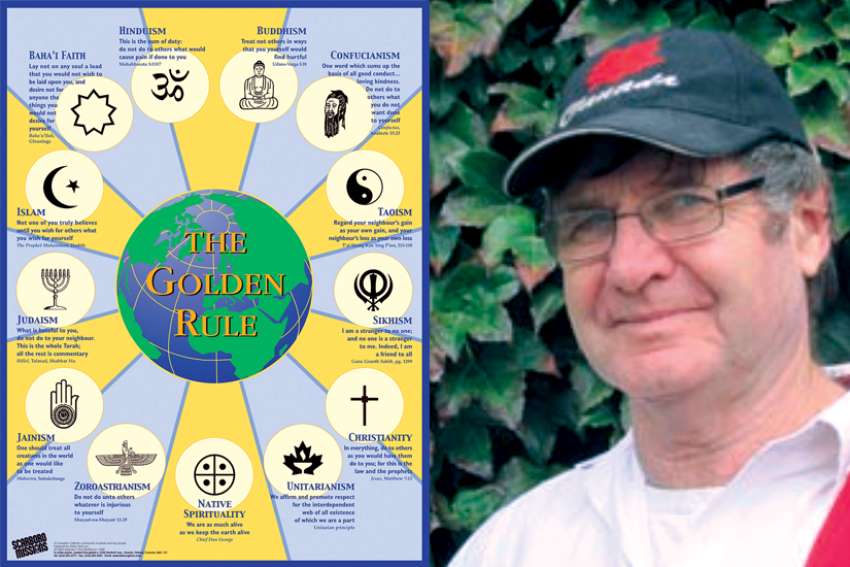Created by Paul McKenna, the colourful poster features the writings of 13 faith traditions from around the world and their various expressions of the fundamental moral principle of treating others as one wants to be treated. Pulled from the Gospel of Matthew in Christianity the poster includes similar teaching found in Judaism, Islam, Native Spirituality, Hinduism, Sikhism and others represented by circular symbols and text surrounding a globe.
Involved in interfaith work for more than 40 years, McKenna is always looking for resources to expand unity around the world. In the 1980s he came across a book on world religions that described seven versions of the Golden Rules from various religions and was triggered into learning more about how other faiths expressed the principle.
More than a decade later he worked with researchers and consulted with religious experts and graphic designers to put the poster together. Produced by Scarboro Missions in Toronto, it was launched in 2000 and since then it has taken on a life of its own.
Ubiquitous in discussions on inter-faith teaching, it’s been translated into several languages, and countless copies can be found around the world everywhere from classrooms to prisons.
"Love your neighbour as yourself, because your neighbour is yourself, and that’s the Golden Rule in full bloom."
“Sacred texts have a lot of moral authority so when you put 13 of them on one poster, that’s a very strong message,” said McKenna. “It’s completely new to some people that there are good things in other religions. They couldn’t see that another religion could have a teaching like this. It expands your consciousness and strikes people. If you were teaching high school religion, you wouldn’t want to start anywhere else especially when if want to promote interfaith cooperation.”
McKenna, a life-long Catholic, has a master’s degree in theology from the University of Toronto and a Master of Divinity from the University of Ottawa. He worked in social service and social justice until he got the call to a vocation in interfaith work. He has worked as an educator, organizer and workshop leader on topics such as interfaith dialogue, Gandhian nonviolence, humour and the Golden Rule.
Following the attacks of 9/11 McKenna was overwhelmed with requests for copies of the poster. He believes the long shelf life of the resource can be attributed to its appeal to the best of humanity. With the many conflicts around the world, including the ongoing war in Ukraine, the poster visually introduces the concept of human oneness, and that to harm another is to harm one’s self.
“I kind of notice when there is crisis, this poster makes more sense to people,” said McKenna. “We are in big trouble in the world. The poster’s message is not necessarily controversial although it can be if you’re stuck on your own religion. It’s sending out this very positive energy to love your neighbour as yourself. Or as one person put it, love your neighbour as yourself, because your neighbour is yourself, and that’s the Golden Rule in full bloom.”
Considered the most universal moral teaching in history, McKenna believes the Golden Rule pushes people to surrender to something greater than themselves. The poster has been purchased in bulk by schools and school boards and has been used in alcohol-recovery programs and psychiatric institutions. The circle of symbols is a visual meditation on unity and oneness. The rays emanating from the globe at the centre help to tie the symbols together.
The poster, McKenna says, is a challenge for people to transcend the superficial features that cause division, such as nationality, political affiliations and race. It’s a declaration for those who desire to transcend cultural differences and religion, in order to eliminate bigotry and practise non-violent retribution.
Ultimately, McKenna believes it’s about understanding that regardless of faith, there is so much to learn from each other.
“Not all religions would use the term Golden Rule because the name maybe came from the West to some degree, but it’s there in their tradition,” said McKenna. “There is a word in Hinduism, Buddhism and Jainism — ahimsa, which means non-violence.
“As Christians we don’t think of our tradition generally as highly non-violent and yet Gandhi described Jesus as the greatest teacher and practitioner of non-violence in world history. We need to learn ahimsa from those traditions because we have not been carrying it on from Jesus who practised it.”

